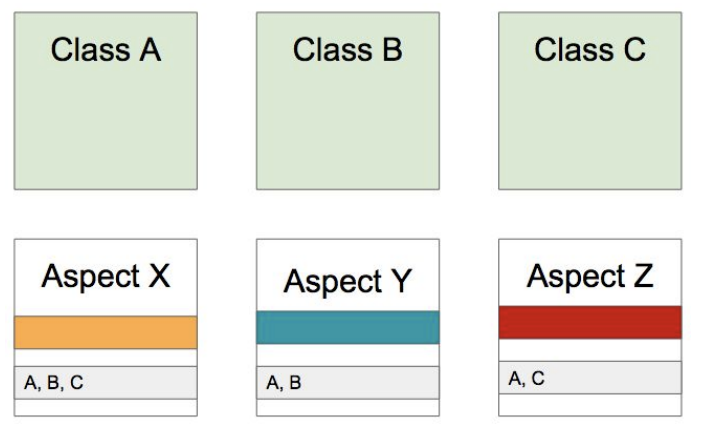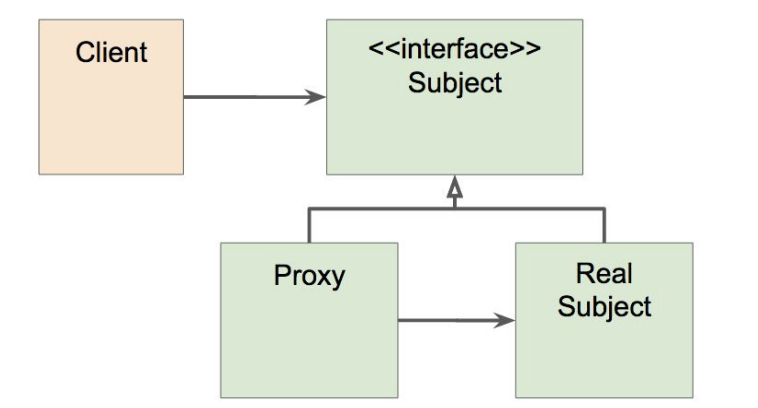스프링 AOP 개념
AOP(Aspect-Oriented-Programming)
OOP를 보완하는 수단으로 흩어진 Aspect를 모듈화 할 수 있는 프로그래밍 기법
흩어진 관심사 (Crosscutting Concerns)
Concerns는 여러 클래스들에 걸쳐서 나타나는 비슷한 코드들, Filed 주입들을 말한다..
ex ) Transaction 처리, 성능관련 로깅 등

AOP를 적용하면...

⇒ 이처럼 공통된 로직, 코드들을 모듈화하여 묶어서 개발할 수 있따.
AOP의 주요 개념
- Aspect와 Target
- Aspect는 모듈을 묶음화 한 것
- Target은 적용 대상
- Advice
- 모듈이 해야할 일들
- Joint point와 Pointcut
- joint point는 합류점을 의미한다. 어떤 메소드, 클래스, filed값 접근시점, 실행시점에 이 Advice를 끼워 넣어라
- Pointcut은 이 모듈을 어디에 적용하는 지를 의미한다.
AOP의 구현체
- AOP는 꼭 Spring, Java에만 국한된 것이 아니다.
- 참고 : https://ko.wikipedia.org/wiki/관점지향프로그래밍
- AspectJ는 자바, 스프링은 Spring AOP(극한적인 기능만 존재)
AOP 적용 방법
- 컴파일 시점
- Java를 .class 파일로 컴파일하는 시점에 조작된 바이트 코드를 실행시킨다. 로드, 런타임은 따로 안들지만, 별도의 컴파일 과정이 필요하다.
- 로드 타임
- 클래스 파일을 로딩하는 시점에 weaving, load time weaving
- 클래스 로딩 시간 증가, load time weaver를 Java agent 에 설정해줘야 함
- 다양한 Aspect 사용 가능
- 런타임
- Proxy 객체로 감싸는 것, 최초의 Bean 설정 시간이 증가한다.
⇒ 컴파일 시점, 로드타임에 AOP 적용 방법은 주로 Aspect에서 사용
⇒ 런타임 시점에 AOP 적용은 주로 Spring AOP에서 사용한다.
스프링 AOP : 프록시 기반 AOP
스프링 AOP 특징
- Proxy 기반의 AOP 구현체
- Spring Bean에만 AOP를 적용할 수 있다.
- 모든 AOP 기능을 제공하는 것이 목적이 아니라, 스프링 IoC와 연동해서 Enterprise Application에서 가장 흔한 문제에 대한 해결책을 제공하는 것이 목적이다.
Proxy Pattern
- 프록시 패턴을 사용하는 이유
- 기존 코드 변경없이 접근 제어, 부가기능을 추가하기 위해서
- 클라이언트는 기존 코드를 건드리지 않고, 인터페이스 타입의 프록시 객체를 사용할 수 있다.

- 프록시 패턴의 문제점
-
매번 프록시 캘르스를 작성해야 한다.
-
여러 클래스, 여러 메소드에 적용하려면 객체들과의 관계도가 복잡해진다.
ex )
// interface public interfaceEventService { voidcreateEvent(); voidpublishEvent(); voiddeleteEvent(); } // Proxy @Primary @Service public class ProxySimpleEventService implements EventService{ @Autowired SimpleEventService simpleEventService; @Override public void createEvent() { long begin = System.currentTimeMillis(); simpleEventService.createEvent(); System.out.println(System.currentTimeMillis()-begin); } @Override public void publishEvent() { long begin = System.currentTimeMillis(); simpleEventService.publishEvent(); System.out.println(System.currentTimeMillis()-begin); } @Override public void deleteEvent() { simpleEventService.deleteEvent(); } } // Real Subject @Service public class SimpleEventService implements EventService{ @Override public void createEvent() { long begin = System.currentTimeMillis(); try { Thread.sleep(1000); } catch (InterruptedException e) { e.printStackTrace(); } System.out.println("create an evnet"); // Crosscutting concern : 각 메소드 마다 공통된 모듈 System.out.println(System.currentTimeMillis()-begin); } @Override public void publishEvent() { long begin = System.currentTimeMillis(); try { Thread.sleep(2000); } catch (InterruptedException e) { e.printStackTrace(); } System.out.println("Published an event"); System.out.println(System.currentTimeMillis()-begin); } public void deleteEvent(){ System.out.println("Delete event"); } }
-
⇒ 그래서 Spring AOP 등장
Spring AOP
- 스프링 IoC 컨테이너가 제공하는 기반 시설과 Dynamic 프록시를 사용해서 여러 복잡한 문제를 해결한다.
- Dynamic Proxy : 동적으로 프록시 객체를 생성하는 방법
- 자바가 제공하는 방법은 인터페이스 기반 프록시 생성
- CGlib은 클래스 기반 프록시도 지원
- 스프링 IoC : 기존 빈을 대체하는 동적 프록시 빈을 만들어서 등록시켜준다.
- 클라이언트 입장에서 코드 변경이 없다.
- AbstractAutoProxyCreator는 BeanPostProcessor를 상속받는다.
- https://docs.spring.io/spring-framework/docs/current/javadoc-api/org/springframework/aop/framework/autoproxy/AbstractAutoProxyCreator.html
- https://docs.spring.io/spring-framework/docs/current/javadoc-api/org/springframework/beans/factory/config/BeanPostProcessor.html
스프링 AOP : @AOP
애노테이션 기반의 스프링 @AOP
사용하기 위해서는 spring-boot-starter-aop 의존성 필요
<dependency>
<groupId>org.springframework.boot</groupId>
<artifactId>spring-boot-starter-aop</artifactId>
</dependency>Aspect 정의
- Aspect에서는 Advice(해야할 일)과 Point-cut(어디에 적용할 것인가, 적용시점)를 정의해야 한다.
- Aspect로 사용할 클래스는 Bean으로 등록되어야 한다.
- @Around 애노테이션을 이용해서 Point-cut을 적용할 수 있다.
@Aspect
@Component
public class PerfAspect {
// createEvent, publlishEvent 메소드에 적용될 aop 이다.
// @Around에 Pointcut을 정의할 수 있다. 즉 적용시점을 정의할 수 있다.
// @Around("execution(* me.jhjhj..*.EventService.*(..))")
// @Around("bean(simpleEventService)")
@Around("@annotation(PerfLogging)")
public Object logPerf(ProceedingJoinPoint pjp) throws Throwable{
long begin = System.currentTimeMillis();
Object retVal = pjp.proceed();
System.out.println(System.currentTimeMillis() - begin);
return retVal;
}
// 메소드 실행 이전에
@Before("bean(simpleEventService)")
public void hello(){
System.out.println("hello");
}
}
// RetentionPolicy에도 다양한 스코프가 존재,
// RetentionPolicy.CLASS : 이 애노테이션을 class 파일까지만 적용하겠다.
@Documented
@Retention(RetentionPolicy.CLASS)
public @interface PerfLogging {
}Point-Cut 정의
- @Pointcut(표현식)
- 주요 표현식
- execution : 패키지 경로 (패키지 경로에 해당하는 대상들 모두가 aop 에 적용)
- @annotation : 별도의 애노테이션 정의 후, aop로 사용하고 싶은 메소드, 클래스만 적용이 가능하다.
- bean : bean 이름 기재
- Point-Cut 조합
- &&, ||, !
Advice 정의
- @Before
- @AfterReturning
- @AfterThrowing
- @Around
✅ Spring AOP 공식 레퍼런스 : https://docs.spring.io/spring-framework/docs/current/reference/html/core.html#aop-pointcuts